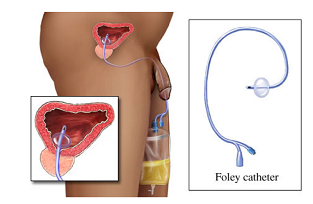Indwelling Urinary Catheter
An indwelling urinary catheter (IDC or Foley catheter) is a flexible tube inserted into the bladder to drain and collect urine continuously. The catheter is held in place by a small, water-filled balloon at its tip to prevent it from falling out.

Types of Indwelling Catheters
There are two main types based on the insertion method:
- Urethral Catheter: Inserted into the bladder through the urethra. This is the most common type.
- Suprapubic Catheter: Inserted into the bladder through a small incision in the abdominal wall, above the pubic bone. This minor surgical procedure is often used for long-term management or if the urethra is blocked or damaged.
Indications
Catheterization is a medical procedure and should only be performed when a clear clinical indication is present. Common reasons include:
- Urinary retention: Inability to empty the bladder.
- Surgery: To drain the bladder before, during, or after certain surgical procedures (e.g., prostate or hip surgery).
- Monitoring: To accurately measure urine output in critically ill patients.
- Incontinence management: When other methods have failed and the patient has severe skin impairment or pressure ulcers.
- Nerve damage: For individuals with neurological conditions like spinal cord injury or multiple sclerosis who cannot control their bladder.
- End-of-life care: To provide comfort
Living with an Indwelling Catheter
- Drainage: The catheter connects to a drainage bag (leg bags for daytime use, larger bags for overnight use) or a catheter valve, which allows for controlled emptying of the bladder.
- Maintenance: Catheters typically need to be changed every few weeks to three months by a healthcare professional.
- Daily Care:
- Wash the area where the catheter enters the body with soap and water daily.
- Keep the drainage bag below the level of the bladder to ensure proper drainage and prevent urine backflow.
- Ensure the tubing is free of kinks or twists.
- Drink plenty of fluids to help flush the urinary system and reduce infection risk
Potential Complications
- The most common and serious complication is a catheter-associated urinary tract infection (CAUTI), as bacteria can form a biofilm on the catheter surface.
- Bladder spasms,
- Blockages,
- Leakage around the catheter, and
- Urethral trauma.
It is important to seek immediate medical advice if you notice signs of infection (fever, cloudy/strong-smelling urine, abdominal pain), a blocked catheter, or if the catheter falls out
Dr Jo Schoeman, Urologist
Suite 46, Level 4
The Wesley Medical Centre
Wesley Hospital
Auchenflower Brisbane




Leave a Reply
Want to join the discussion?Feel free to contribute!